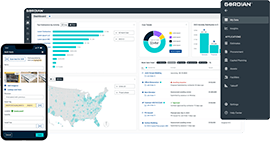Gordian’s FCA Options: Life Cycle Analysis
Tracking all physical assets, including their current condition and performance, and communicating needs and deficiencies in a way all stakeholders understand, can be a daunting task for organizational leaders. To help them gather and analyze all this data, these leaders often commission a facility condition assessment (FCA). All facilities have unique characteristics such as age, size, function or level of strategic importance that make the process of measuring and assessing conditions different for every project. Thus, conducting an FCA should not be a one-size-fits-all process. The key is getting the right level of detail for the decisions you are making. Different assessment types yield different levels of detail and can be strategically applied to different assets.
But how do you know what type of assessment you need? That depends on the level of detail you require and the time, budget and in-house expertise you have at your disposal.
Gordian offers several types of FCAs including Life Cycle Analysis, Core Systems Assessments, Detailed Assessments and Engineering Assessments that we’ve been discussing in an ongoing series of blog posts. In this installment, we’ll dive into Life Cycle Analysis, an innovative, data-driven assessment that provides a snapshot of potential investment needs.
Life Cycle Analysis: The Basics
Traditionally, when people think of an FCA they picture an assessor – often an engineer or other qualified professional – walking from asset to asset and evaluating the age and condition of every component. It’s a labor-intensive and time-consuming process that is often absolutely necessary. But not always.
Gordian’s Life Cycle Analysis minimizes human intervention by using data and statistical modeling to estimate the renewal and replacement costs of common building systems. This type of FCA does not take into consideration the maintenance or inspection activities that have occurred over the life of the facility or the repair and replacement costs for specific systems.
Here’s a brief example of how a Life Cycle Analysis helps leaders gain a broad understanding of needs. Imagine a 25,000-square-foot, two-story classroom facility originally built 30 years ago. With little time and cost invested, it would be easy, based on facility age, to generalize that the roof needs to be redone and that HVAC systems need an upgrade. From this generalization, one could roughly estimate the costs of this work.
Essentially, the Life Cycle Analysis tells organizations the approximate costs of replacing a general system of a given age, but it does not tell organizations the approximate costs of replacing their specific system. While this assessment will not produce the specific detail that a Detailed or Engineering Assessment can, it is a useful supplement.

When You Need a Life Cycle Analysis
This type of FCA is most useful for gaining a high-level understanding of asset conditions and replacement and renewal costs. That’s why it’s best to use a Life Cycle Analysis early in the budgeting process. The modeled data will provide a starting point from which leaders can begin deciding how to allocate funding. If a Life Cycle Analysis shows the potential for a cost spike, organizations may choose to conduct an in-person, on-site FCA to verify the model’s prediction.
Decision-makers can also use Gordian’s statistical models to quickly estimate costs for assets carrying less strategic importance, freeing them to focus their efforts on more urgent priorities.
Here are a few questions you can ask to determine if a Life Cycle Analysis is the right Gordian FCA for your facility:
- Where is your organization in the budgeting process?
- What is the asset’s strategic importance?
- When was the asset built?
Learn how you can decide which Gordian FCAs are right for you by watching our on-demand webinar, Building Your Insights Inventory: How to Develop a Facilities Assessment Strategy.
Combining Gordian FCA Options for Savvy Investments
A Life Cycle Analysis is unlikely to be the only Gordian FCA your organization conducts as it hammers out how to allocate funds. It’s not built for that. But as part of a strategic spectrum of assessments, it can help fill knowledge gaps regarding the condition of your facilities portfolio and provide some general budgeting direction. It’s a low-cost, low-resolution solution for quickly estimating renewal and replacement costs to establish a baseline for potential needs. This baseline can be refined and validated by more intensive Gordian FCAs as time goes on and conditions change.






